 |

 |
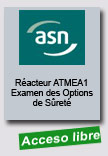 |
Réacteur ATMEA1 - Examen des Options de Sûreté
L’Autorité de Sûreté Nucléaire, 24 janvier 2012, 86 p.
A l’issue d’un examen qui a duré 18 mois, l’ASN émet un avis positif sur les options de sûreté du projet de réacteur ATMEA1.
L’ASN a mené, avec l’appui technique de l’Institut de radioprotection et de sûreté nucléaire (IRSN), la revue des options de sûreté du réacteur à eau sous pression ATMEA1. Ce réacteur de moyenne puissance (1100 MWe) est conçu par la société ATMEA, coentreprise formée par AREVA et Mitsubishi Heavy Industries (MHI).
Cette revue des options de sûreté a été effectuée à la demande de la société ATMEA. Bien qu’elle ne s’inscrive pas aujourd’hui
|
dans la perspective d’une demande d’autorisation de création d’un tel réacteur en France, cette revue a été menée dans les conditions qui encadrent la création des installations nucléaires de base sur le territoire français. L’ASN a notamment recueilli en 2011 les avis des Groupes permanents d’experts pour les réacteurs nucléaires (GPR) et pour les équipements sous pression nucléaires (GPESPN) qui concernent les options de sûreté de ce nouveau réacteur.
L’ASN rend publics son avis et le rapport sur lequel il s’appuie, qui concluent que les options de sûreté retenues par la société ATMEA pour son projet de réacteur sont globalement satisfaisantes au regard des exigences françaises. Dans un contexte français, cet avis serait une étape préalable à la procédure d’autorisation de création d’un tel réacteur.
Au stade de la conception détaillée, la société ATMEA devra être particulièrement vigilante sur l’optimisation de l’exposition des travailleurs aux rayonnements ionisants, sur les dispositions nécessaires à l’ « élimination pratique » de certains accidents ou à l’exclusion de la rupture de certaines tuyauteries et, bien évidemment, sur la poursuite de la prise en compte des enseignements tirés de l’accident survenu à la centrale nucléaire de Fukushima Daiichi (Japon).
L’ASN rappelle qu’en France, la demande d’autorisation de création est portée par l’exploitant et non par le concepteur du réacteur.
Avis sur les options de sûreté du projet de réacteur ATMEA1
Extraído de:
http://www.asn.fr/index.php/S-informer/Actualites/2012/Projet-de-reacteur-ATMEA1
|
 |
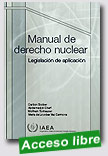 |
Manual de Derecho Nuclear - Legislación de aplicación
IAEA, 2012, 167 p.
El presente manual se basa en dos consideraciones básicas. En primer lugar, que para la redacción de legislación nuclear no existe una fórmula única. Una legislación nuclear solo será eficiente y eficaz si se ajusta a la estructura general jurídica y reglamentaria de un Estado y refleja el nivel y los objetivos de su programa nuclear. En segundo lugar, a pesar de los distintos requisitos de los ordenamientos jurídicos nacionales, sería muy útil alcanzar el mayor grado posible de armonización
|
y coherencia entre los marcos legislativos de los Estados en el ámbito nuclear. Esto es particularmente conveniente en una esfera que puede conllevar especiales riesgos para la seguridad tecnológica y física de la población, entre ellos los de alcance transfronterizo, y en la que se realizan frecuentes transferencias de materiales y tecnología entre los Estados.
El propósito del presente manual, en el que se trata de alcanzar un equilibrio razonable entre esas dos consideraciones, es facilitar el acceso a un conjunto bien organizado de material de consulta para ayudar a los Estados a redactar su legislación nuclear.
Extraído de:
http://www-pub.iaea.org/MTCD/Publications/PDF/Pub1456s_web.pdf
|
 |
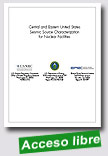 |
Central and Eastern United States Seismic Source Characterization for Nuclear Facilities
U.S. Nuclear Regulatory Commission; U.S. Department of Energy; Electric Power Research Institute, January 2012, Report Preface 122 p.
This report describes a new seismic source characterization (SSC) model for the Central and Eastern United States (CEUS). It will replace the Seismic Hazard Methodology for the Central and Eastern United States, EPRI Report NP-4726 (July 1986) and the Seismic Hazard Characterization of 69 Nuclear Plant Sites East of the Rocky Mountains, Lawrence Livermore National
|
Laboratory Model, (Bernreuter et al., 1989). The objective of the CEUS SSC Project is to develop a new seismic source model for the CEUS using a Senior Seismic Hazard Analysis Committee (SSHAC) Level 3 assessment process. The goal of the SSHAC process is to represent the center, body, and range of technically defensible interpretations of the available data, models, and methods. Input to a probabilistic seismic hazard analysis (PSHA) consists of both seismic source characterization and ground motion characterization. These two components are used to calculate probabilistic hazard results (or seismic hazard curves) at a particular site. This report provides a new seismic source model.
Site de Download Project Report | Report Preface
Extraído de:
http://www.ceus-ssc.com/PDF/Preface.pdf
|
 |
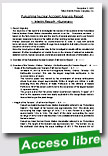 |
|
technical issues, which were clarified through the investigation that mainly focused on the sequence of events of the accident.
Since the investigation is still under way, further investigation results will be compiled and released. (Further investigation will mainly focus on the release of radioactive materials, radiation control, human resources, material procurement, disclosure of information, etc.)
Summary | Full report | Supplementary Volume 1 - 2
Extraído de:
http://www.tepco.co.jp/en/press/corp-com/release/betu11_e/images/111202e13.pdf |
 |
 |
Control of Orphan Sources and Other Radioactive Material in the Metal Recycling and Production Industries
IAEA Safety Standards Series, 2012, 82 p.
Accidents involving orphan sources and other radioactive material in the metal recycling and production industries have resulted in serious radiological accidents as well as in harmful environmental, social and economic impacts. This Safety Guide provides recommendations, the implementation of which should prevent such accidents and provide confidence that scrap metal and recycled products are safe. Contents: 1. Introduction; 2. |
Protection of people and the environment; 3. Responsibilities; 4. Monitoring for radioactive material; 5. Response to the discovery of radioactive material; 6. Remediation of contaminated areas; 7. Management of recovered radioactive material; Annex I: Review of events involving radioactive material in the metal recycling and production industries; Annex II: Categorization of radioactive sources; Annex III: Some examples of national and international initiatives.
Extraído de:
http://www-pub.iaea.org/books/IAEABooks/8642/Control-of-Orphan-Sources-and-Other-Radioactive-Material-in-the-Metal-Recycling-and-Production-Industries |
 |
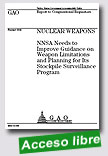 |
Nuclear Weapons: NNSA Needs to Improve Guidance on Weapon Limitations and Planning for Its Stockpile Surveillance Program
Government Accountability Office (GAO), February 8 2012, 39 p.
Most weapons in the U.S. nuclear stockpile were produced over 20 years ago and are being sustained beyond original design lifetimes. It is critical to ensure that these weapons are safe, secure, and reliable to perform as the nation’s nuclear deterrent. The National Nuclear Security Administration (NNSA), a |
semiautonomous agency within the Department of Energy, is responsible for the nation’s nuclear weapons program. NNSA identifies nuclear weapon limitations—areas where military requirements may not be met—and conducts nonnuclear tests to evaluate the condition and reliability of weapons through its nuclear stockpile surveillance program. GAO was asked to determine the (1) number and types of such limitations and any concerns raised by Department of Defense (DOD) officials, and (2) actions NNSA has taken to implement its prior recommendations for the nuclear stockpile surveillance program. GAO reviewed agency documents, analyzed limitations, and interviewed key NNSA and DOD official.
Highlights
Extraído de:
http://www.gao.gov/assets/590/588307.pdf
|
 |
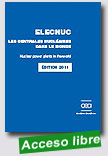
|
Elecnuc - Les centrales nucléaires dans le monde (Édition 2011)
Commissariat à l’Énergie Atomique et aux Énergies Alternatives, 2011, 73 p.
Cette nouvelle version d'"Elecnuc" contient des informations plus générales sur les perspectives nationales du secteur électrique.
|
Extraído de:
hhttp://www.cea.fr/content/download/49912/925958/file/CEA-elecnuc-2011.pdf
|
 |
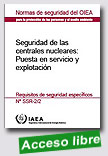 |
Seguridad de las Centrales Nucleares: Puesta en Servicio y Explotación
OIEA - Colección de Normas de Seguridad, 2012, 52 p.
El objetivo de esta publicación es determinar los requisitos que, a la luz de la experiencia y el estado actual de la tecnología, deben cumplirse para garantizar la explotación segura de las centrales nucleares. Estos requisitos se rigen por el objetivo y los principios de seguridad establecidos en los Principios fundamentales de seguridad.
La presente publicación trata sobre la puesta en servicio y la
|
explotación seguras de una central nuclear. Abarca la puesta en servicio y la explotación hasta la retirada del combustible nuclear de la central, así como el mantenimiento y las modificaciones hechas a lo largo de la vida útil de la central. Abarca igualmente los preparativos para la clausura, pero no la fase de clausura propiamente dicha.
La publicación establece también requisitos adicionales relativos únicamente a la puesta en servicio. Se tienen en cuenta la explotación normal y los incidentes operacionales previstos, así como las condiciones de accidente.
Extraído de:
http://www-pub.iaea.org/MTCD/Publications/PDF/Pub1513s_web.pdf
|
 |
 |
Lessons from Fukushima
Greenpeace, February 2012, 52 p.
SNETP gives nuclear safety the highest priority in its vision and Strategic Research Agenda. European technical safety organizations (TSO’s) are involved in the activities of the platform governance and working groups. SNETP promotes safety related research and harmonization at European level, for current and future generation of nuclear fission technologies. This is the reason why the SNETP Governing Board decided to empowered
|
Extraído de:
http://www.snetp.eu/www/snetp/images/stories/Docs-Newsflash/Implication_of_Fukushima_SNETP.pdf
|
 |
|
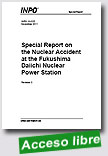
|
Special Report on the Nuclear Accident at the Fukushima Daiichi Nuclear Power Station
Institute of Nuclear Power Operations, November 2011, 104 p.
It has been almost 12 months since the Fukushima nuclear disaster began. Although the Great East Japan earthquake and the following tsunami triggered it, the key causes of the nuclear accident lie in the institutional failures of political influence and industry-led regulation. It was a failure of human institutions to acknowledge real reactor risks, a failure to establish and enforce appropriate nuclear safety standards and a failure to ultimately protect the public and the environment. |
|
|
